外研版选修八Module2 The Renaissance-Grammar课件(43张PPT)
文档属性
| 名称 | 外研版选修八Module2 The Renaissance-Grammar课件(43张PPT) | 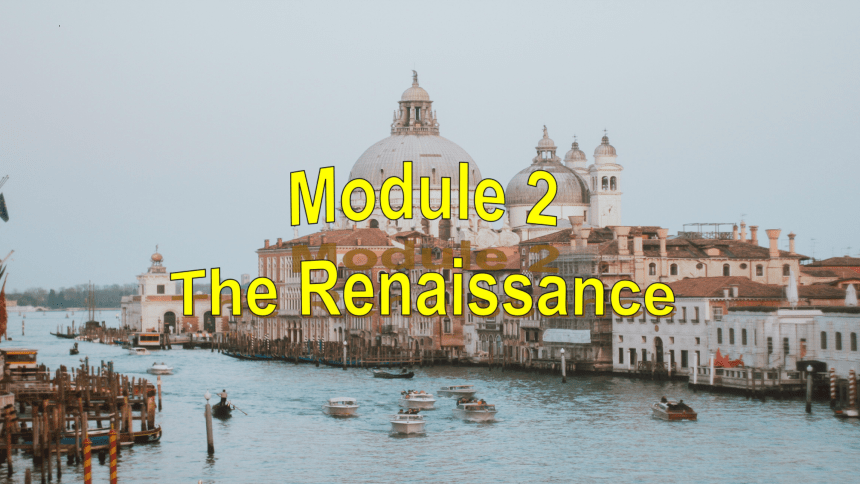 | |
| 格式 | zip | ||
| 文件大小 | 6.1MB | ||
| 资源类型 | 教案 | ||
| 版本资源 | 外研版 | ||
| 科目 | 英语 | ||
| 更新时间 | 2022-03-09 08:43:11 | ||
图片预览



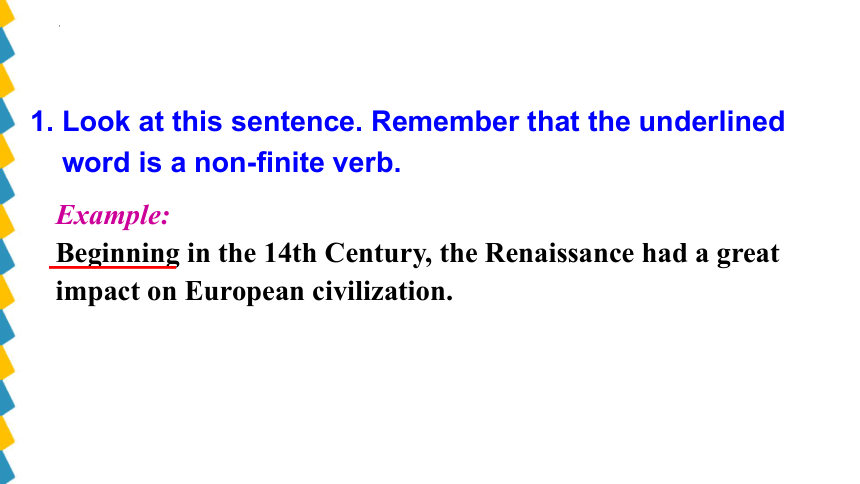
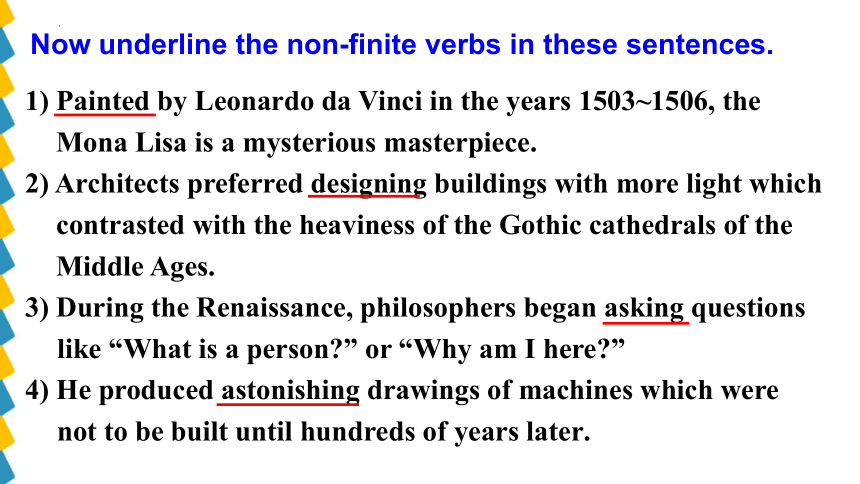


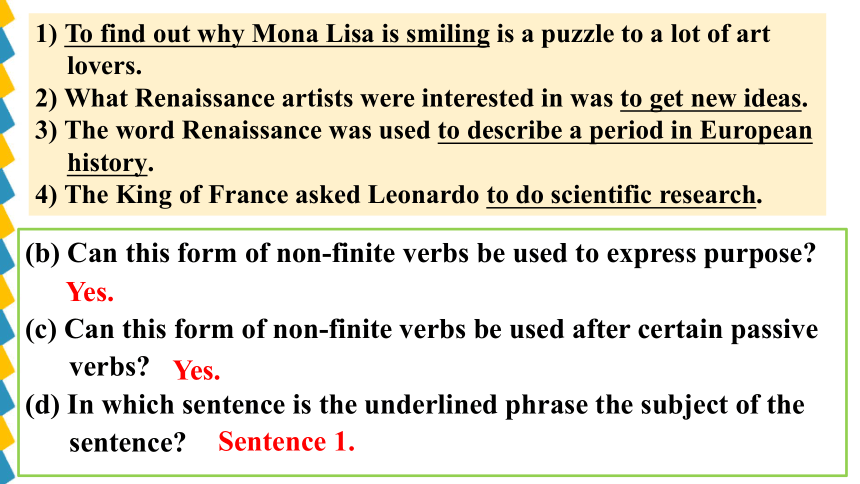
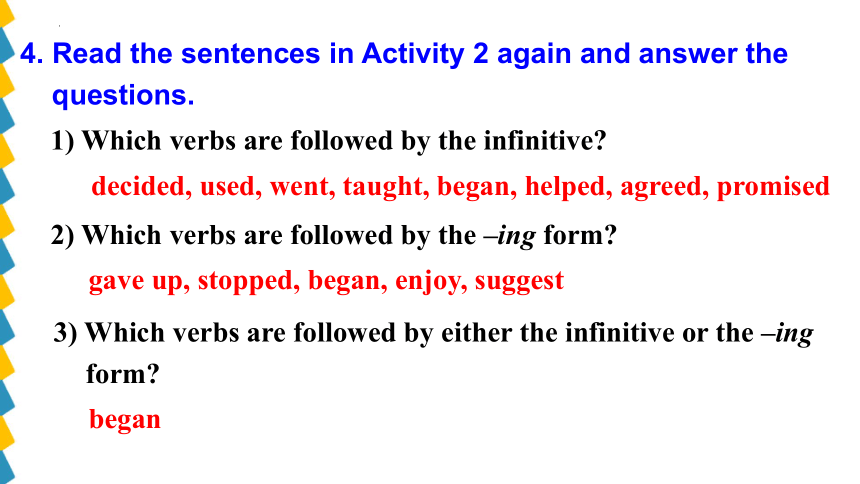
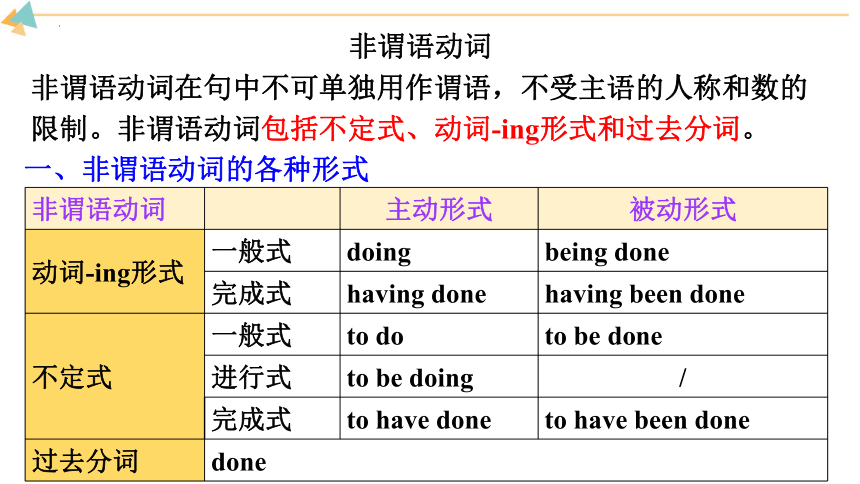

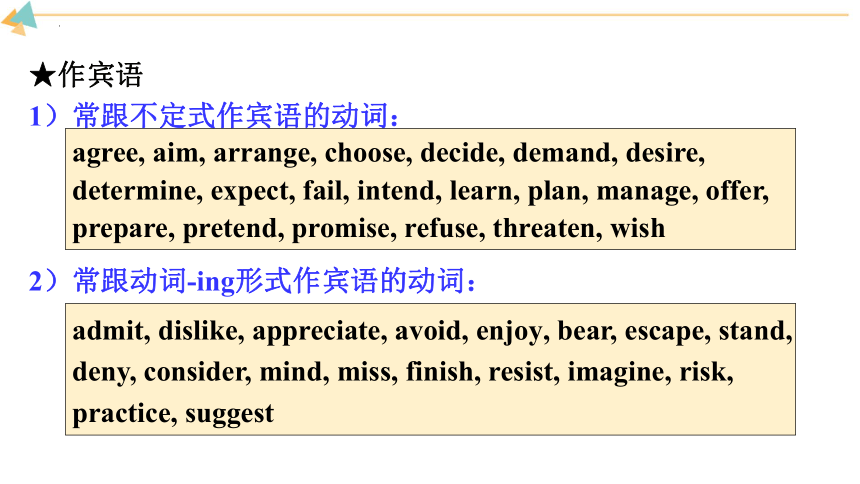
文档简介
(共43张PPT)
Module 2
The Renaissance
Review of non-finite verbs(1)(2)
To review and practise the usage of non-finite verbs
Example:
Beginning in the 14th Century, the Renaissance had a great impact on European civilization.
1. Look at this sentence. Remember that the underlined word is a non-finite verb.
1) Painted by Leonardo da Vinci in the years 1503~1506, the Mona Lisa is a mysterious masterpiece.
2) Architects preferred designing buildings with more light which contrasted with the heaviness of the Gothic cathedrals of the Middle Ages.
3) During the Renaissance, philosophers began asking questions like “What is a person ” or “Why am I here ”
4) He produced astonishing drawings of machines which were not to be built until hundreds of years later.
Now underline the non-finite verbs in these sentences.
Which non-finite verb phrases:
(a) contain –ing forms
(b) contain –ed forms
(c) are used as subjects
(d) are used as objects
(e) are used as adjectives
2, 3, 4
1
no
2. Read the sentences in Activity 1 again and answer the questions.
2, 3
4
1) To find out why Mona Lisa is smiling is a puzzle to a lot of art lovers.
2) What Renaissance artists were interested in was to get new ideas.
3) The word Renaissance was used to describe a period in European history.
4) The King of France asked Leonardo to do scientific research.
3. Look at the sentences and answer the questions.
(a) What form of non-finite verbs are used in all the underlined phrases
The infinitive.
(b) Can this form of non-finite verbs be used to express purpose
(c) Can this form of non-finite verbs be used after certain passive verbs
(d) In which sentence is the underlined phrase the subject of the sentence
Yes.
1) To find out why Mona Lisa is smiling is a puzzle to a lot of art lovers.
2) What Renaissance artists were interested in was to get new ideas.
3) The word Renaissance was used to describe a period in European history.
4) The King of France asked Leonardo to do scientific research.
Yes.
Sentence 1.
4. Read the sentences in Activity 2 again and answer the questions.
decided, used, went, taught, began, helped, agreed, promised
1) Which verbs are followed by the infinitive
2) Which verbs are followed by the –ing form
gave up, stopped, began, enjoy, suggest
began
3) Which verbs are followed by either the infinitive or the –ing form
非谓语动词
非谓语动词在句中不可单独用作谓语,不受主语的人称和数的限制。非谓语动词包括不定式、动词-ing形式和过去分词。
一、非谓语动词的各种形式
非谓语动词 主动形式 被动形式
动词-ing形式 一般式 doing being done
完成式 having done having been done
不定式 一般式 to do to be done
进行式 to be doing /
完成式 to have done to have been done
过去分词 done
二、非谓语动词的句法功能
1. 动词-ing形式和不定式作主语和宾语
★作主语
用法
不定式 表示具体的或一次性的动作
动词-ing形式 一般或抽象的多次性的动作
★作宾语
1)常跟不定式作宾语的动词:
2)常跟动词-ing形式作宾语的动词:
agree, aim, arrange, choose, decide, demand, desire, determine, expect, fail, intend, learn, plan, manage, offer, prepare, pretend, promise, refuse, threaten, wish
admit, dislike, appreciate, avoid, enjoy, bear, escape, stand, deny, consider, mind, miss, finish, resist, imagine, risk, practice, suggest
3) 有些动词既可以跟动词-ing形式,又可以跟不定式做宾语,但意义有所区别。这类动词有:
remember, forget, regret, stop, try, mean。
4) need, want, require既可以用动词-ing形式也可用不定式作宾语,但用法不同。
用法
sb. need(s) / want(s) to do sth.
sth. need(s)/ want(s)/ require(s)+ doing/ to be done
(主动形式表被动意义)
5) 无论是普通介词还是含介词的动词短语,一般情况下都要用动词-ing形式作宾语。
2. 非谓语动词作定语
1)不定式作定语
a. 作定语的不定式与它所修饰的名词或代词在逻辑上可能是主谓关系,也可能是动宾关系。如:
The next train to arrive was from New York.
It was a game to remember.
b. 名词前有only, last, next,序数词或形容词的最高级时,且名词是作定语的非谓语动词的执行者时,其后常用不定式作定语。如:
Rita was the only person to complain.
He was the first man to fly across the Atlantic.
Alex is the best man to do the job.
c. 有些名词的同根动词后常跟不定式作宾语,因而这些名词后也常跟不定式作定语。常见的有:wish, decision, refusal, arrangement, intention, agreement, hope, need, plan, promise, failure, attempt, offer, warning。
c. 有些名词的同根动词后常跟不定式作宾语,因而这些名词后也常跟不定式作定语。常见的有:wish, decision, refusal, arrangement, intention, agreement, hope, need, plan, promise, failure, attempt, offer, warning。
如:Their offer to assist in the work was not taken seriously.
(比较:They offered to assist in the work.)
d. 有些名词常用不定式作定语说明其内容。
chance, opportunity, reason, way, effort, measure, movement, power, right, skill, strength, struggle, idea
如:He has a strange way to make his classes lively and interesting.
2)动词-ing形式作定语
及物动词 -ing形式作定语 被修饰的名词与非谓语动词为逻辑上的主动关系,v-ing形式表示被修饰词的特征 I have never seen a more moving movie.
不及物动词-ing形式作定语 表示动作正在进行 The woman sending her children to school is my history teacher.
3)过去分词作定语
及物动词 done 被修饰的名词与非谓语动词为被动关系且表示动作已经完成或表状态 He is a teacher loved by his students.
不及物动词过去分词 表示动作已经完成 We’ve met the doctors sent to work here by the city hospital.
4)有些表示感觉的动词,其动词-ing形式表示“令人……的”,过去分词形式表示“感到……的”,如:exciting和excited。
类别 用法 例句
不定式 用来说明主语的具体内容。 Your task today is to wash the curtains.
动词-ing形式 多指抽象的、概念性的动作,可以是多次的经常性的行为;表特征,意为“令人……的” His favorite sport is playing basketball.
The film is exciting.
过去分词 表心里状态,意为“感到……的” He was excited at the news.
3. 非谓语动词作表语
4. 非谓语动词作状语
1) 不定式作状语,常表示目的、原因、结果等。不定式作结果状语时,常用于“only +不定式”结构,表示未曾预料到的或令人不快的结果。如:
A friend of mine came to see me tonight.
I jumped with joy to hear it.
Alan lifted a rock only to drop it on his own feet.
2) 动词-ing形式或过去分词作状语时,可以表示时间、原因、结果、条件、让步、方式、伴随情况等,其前可加连词while,
when, once, if, unless等。如:
Crossing the street, he was knocked down by a car.
Frightened by the noise outside, the little girl dared not sleep in her bedroom.
He fell off the bike, breaking his left leg.
Seen through the eyes of a young friend, Einstein was a simple, modest and ordinary man.
A group of children were sitting around the teahcer, playing games.
When heated, ice will be changed into water.
5. 非谓语动词作补语
1)用不定式作补语的动词及动词词组:
advise, allow, ask, beg, cause, encourage, expect, forbid, force, get, intend, invite, like, love, order, persuade, prefer, remind, require, teach, tell, want, warn, wish, wait for, call on, depend on
2) 感官动词和使役动词后常接省略to的不定式作宾语补足语,但用于被动语态时,需把to补出来。如:
Someone saw Mary enter the building about the time the crime was committed.
Mary was seen to enter the building about the time the crime was committed.
另外,感官动词后也可接动词-ing形式作补语,表示动作正在
进行。如:
Once in the middle of the night I woke and heard the wind
blowing.
三、非谓语动词独立结构
非谓语动词可有其独立的逻辑主语。这种逻辑主语常常是名词或代词,置于非谓语动词之前,二者构成非谓语动词独立结构。这种独立结构常用作状语。如:
Lots of homework to do, I have to stay at home all day.
The audience having seated themselves, the concert began.
The task completed, we had a global traveling.
Leonardo was born in a small town in Tuscany, in the center of Italy. At school his teachers were astonished / astonishing by his talent. But Leonardo thought his progress was disappointed / disappointing because he hadn’t learnt enough. So instead of relaxing / relaxed evenings spent with friends, Leonardo preferred studied / studying Latin by himself. He was good at everything: he was a strong athlete and he had a fine sung / singing voice. But he was especially interested / interesting in painting.
Activity 3 on P18
Underline the correct form of the verb.
When he was 14 he went to work for the well-known artist Verrocchio and soon became a greater artist than his master. His first known drawing, showing / showed a valley in Tuscany, is astonished / astonishing. It shows a completely new approach to perspective. The scene looks real.
Activity 4 on P19
Complete the passage with the correct phrase from the box and compare your answers with your partners.
a stolen page delighted Finding the October page
illustrated with a hunting scene Measuring just 130mm × 95mm
showing religious days £10m
The beautifully illustrated Sforza Hours The lost pages
Lost Page Found After 500 Years
A 15th century Italian Renaissance book costing (1) __________ has finally been completed after (2) _____________ was returned to the rest of the book.
£10m
a stolen page
(3) ____________________________________was started around 1490 but at least three pages were stolen from the artist before it was finished. (4) ______________ were discovered 65 years ago and until this year one stayed in a private collection. The British Library paid £191,000 to a private US dealer for the final page. (5) _____________________________, the book is thought to be one of the library’s greatest treasures.
The beautifully illustrated Sforza Hours
The lost pages
a stolen page delighted Finding the October page
illustrated with a hunting scene Measuring just 130mm × 95mm
showing religious days £10m
The beautifully illustrated Sforza Hours The lost pages
Measuring just 130mm × 95mm
It contains a calendar (6) _____________________ alongside pictures for each month. The final page – October – is (7) ____________________________, a typical activity for the time of
showing religious days
illustrated with a hunting scene
a stolen page delighted Finding the October page
illustrated with a hunting scene Measuring just 130mm × 95mm
showing religious days £10m
The beautifully illustrated Sforza Hours The lost pages
“The Sforza Hours is one of the greatest Renaissance books,” said Scot McKendrick of the British Library. “(8) ______________________ ends a 500- year search and we are (9) _________ that all parts of the Hours have now been returned to the British Library.”
a stolen page delighted Finding the October page
illustrated with a hunting scene Measuring just 130mm × 95mm
showing religious days £10m
The beautifully illustrated Sforza Hours The lost pages
Finding the October page
delighted
1) Leonardo decided ___________ (become) an artist when he was a boy.
2) He used _________ (draw) everything he saw around him.
3) He went to France _________ (work) for the King.
4) When he got there, he gave up _________ (paint).
5) The Renaissance artists taught us _______ (see) nature in a new way.
to become
to draw
Activity 2 on 21
Complete the sentences with the correct form of the verbs in brackets. More than one form may be possible.
to see
painting
to work
6) They stopped __________ (follow) the old rules about color and perspective.
7) They began ____________________________ (experiment) with light and shade.
8) The increase in international trade helped Renaissance ideas __________________ (spread) quickly.
9) Many artists agreed __________ (work) for wealthy patrons.
10) Today lots of people enjoy _______ (go) to art galleries.
11) You promised ________ (take) me to the Louvre!
12) I suggest ________ (read) about the Renaissance before we go.
following
spread /to spread
to work
to experiment / experimenting
to take
reading
going
Activity 4 on 21
Complete the passage with the correct form of the verbs.
Vesalius
Vesalius was born in Brussels and went to Paris (1) ___________ (complete) his medical training. He became Professor at Padua University in Italy, an important centre for (2) ________ (train) doctors during the Renaissance. Vesalius had met artists who were studying the bones of the human body and (3) ___________ (cut up) bodies to make their paintings more lifelike. He said it was important for doctors (4) ____________ (examine) human bodies (5) ___________ (find out) how they work.
to complete
training
cutting up
to examine
to find out
As the Catholic Church did not allow this, Vesalius had to remove dead bodies that were (6) _______ (bury). He even stole a body from a prison (7) ________ (study). Vesalius wrote a great book called “ The Fabric of the Human Body”, (8) __________ (describe) how parts of the body work. The famous artist Titian produced over 200 drawings, (9) ________ (show) the human body in greater detail than ever before. (10) ________ (print) in 1543, the book was soon available in every medical school in Europe. His work encouraged other scientists to become more (11) ___________ (question). After Vesalius it became more important (12) ________ (study) how the human body works.
buried
to study
describing
showing
Printed
to study
questioning
1. Chinese researchers hope to use the instruments onboard Chang’e-4 ________ (find) and study areas of the South Pole-Aitken basin. (2020年新课标全国卷I)
2. The next morning he hired a boat and set out ________ (find) the well-known painter. …And when he saw the mists rising from the river and the soft clouds ____________ (surround) the mountain tops, he was reduced to tears. (2020年新课标全国卷III)
to find
to find
surrounding
3. As well as looking at exhibits, visitors can play with computer simulations (模拟) and imagine themselves living at a different time in history or _________ (walk) through a rainforest.
(2020年全国新高考I卷)
4. Agriculture gave people their first experience of the power of technology ___________ (change) lives.
…Later, they learned to work with the seasons, planting at the right time and in dry areas, _________ (make) use of annual floods to irrigate (灌溉) their fields. (2020浙江卷)
walking
to change
making
I. 选用括号内合适的内容补全下面句子。
1. The managers discussed the plan that they would like to see __________ (carry out, carried out) the next year.
2. _________ (Found, Founded) in 1636, Harvard is one of the most famous universities in the United States.
3. There was terrible noise __________ (following, followed) the sudden burst of light.
4. European football is played in 80 countries, _________ (make, making) it the most popular sport in the world.
carried out
Founded
following
making
5. Paul can’t attend the party ____________ (to be held, being held) at Tom’s house at present because he is preparing for an important speech.
6. The way you thought of __________ (solving, to solve) the math problem was greatly creative.
7. The first textbooks __________ (written, to be written) for teaching English as a foreign language came out in the 16th century.
being held
to solve
written
II. 用括号内动词的正确形式完成下面短文。
An old man goes to his doctor, 1. _____________ (complain) about a pain in his leg that doesn’t heal, and wants a diagnosis (诊断) and explanation. The doctor checks out his leg, only 2. ________ (find) everything right. 3. ________ (give) the old guy a full physical exam, the doctor still can’t come up with any possible explanation for the pain.
4. _________ (hand) the patient his bill, the doctor says, “I’m sorry but the pain in your leg is simply caused by old age; there’s nothing I can do about it.”
complaining
to find
Giving
Handing
5. __________ (surprise), the old man answers, “That’s impossible! That can’t be!”
The doctor says, “What do you mean by 6. ________ (say) that I’m the expert here; if you know so much, how can you say it’s not old age ”
The patient answers, “Honestly 7. __________ (speak), I’m no doctor but it doesn’t take a medical degree 8. ________ (tell) that your diagnosis is wrong. Clearly you’re mistaken. After all my other leg feels just fine. And it’s the same age!”
Surprised
saying
speaking
to tell
1. Review Grammar.
2. Finish the exercises on the workbook.
Module 2
The Renaissance
Review of non-finite verbs(1)(2)
To review and practise the usage of non-finite verbs
Example:
Beginning in the 14th Century, the Renaissance had a great impact on European civilization.
1. Look at this sentence. Remember that the underlined word is a non-finite verb.
1) Painted by Leonardo da Vinci in the years 1503~1506, the Mona Lisa is a mysterious masterpiece.
2) Architects preferred designing buildings with more light which contrasted with the heaviness of the Gothic cathedrals of the Middle Ages.
3) During the Renaissance, philosophers began asking questions like “What is a person ” or “Why am I here ”
4) He produced astonishing drawings of machines which were not to be built until hundreds of years later.
Now underline the non-finite verbs in these sentences.
Which non-finite verb phrases:
(a) contain –ing forms
(b) contain –ed forms
(c) are used as subjects
(d) are used as objects
(e) are used as adjectives
2, 3, 4
1
no
2. Read the sentences in Activity 1 again and answer the questions.
2, 3
4
1) To find out why Mona Lisa is smiling is a puzzle to a lot of art lovers.
2) What Renaissance artists were interested in was to get new ideas.
3) The word Renaissance was used to describe a period in European history.
4) The King of France asked Leonardo to do scientific research.
3. Look at the sentences and answer the questions.
(a) What form of non-finite verbs are used in all the underlined phrases
The infinitive.
(b) Can this form of non-finite verbs be used to express purpose
(c) Can this form of non-finite verbs be used after certain passive verbs
(d) In which sentence is the underlined phrase the subject of the sentence
Yes.
1) To find out why Mona Lisa is smiling is a puzzle to a lot of art lovers.
2) What Renaissance artists were interested in was to get new ideas.
3) The word Renaissance was used to describe a period in European history.
4) The King of France asked Leonardo to do scientific research.
Yes.
Sentence 1.
4. Read the sentences in Activity 2 again and answer the questions.
decided, used, went, taught, began, helped, agreed, promised
1) Which verbs are followed by the infinitive
2) Which verbs are followed by the –ing form
gave up, stopped, began, enjoy, suggest
began
3) Which verbs are followed by either the infinitive or the –ing form
非谓语动词
非谓语动词在句中不可单独用作谓语,不受主语的人称和数的限制。非谓语动词包括不定式、动词-ing形式和过去分词。
一、非谓语动词的各种形式
非谓语动词 主动形式 被动形式
动词-ing形式 一般式 doing being done
完成式 having done having been done
不定式 一般式 to do to be done
进行式 to be doing /
完成式 to have done to have been done
过去分词 done
二、非谓语动词的句法功能
1. 动词-ing形式和不定式作主语和宾语
★作主语
用法
不定式 表示具体的或一次性的动作
动词-ing形式 一般或抽象的多次性的动作
★作宾语
1)常跟不定式作宾语的动词:
2)常跟动词-ing形式作宾语的动词:
agree, aim, arrange, choose, decide, demand, desire, determine, expect, fail, intend, learn, plan, manage, offer, prepare, pretend, promise, refuse, threaten, wish
admit, dislike, appreciate, avoid, enjoy, bear, escape, stand, deny, consider, mind, miss, finish, resist, imagine, risk, practice, suggest
3) 有些动词既可以跟动词-ing形式,又可以跟不定式做宾语,但意义有所区别。这类动词有:
remember, forget, regret, stop, try, mean。
4) need, want, require既可以用动词-ing形式也可用不定式作宾语,但用法不同。
用法
sb. need(s) / want(s) to do sth.
sth. need(s)/ want(s)/ require(s)+ doing/ to be done
(主动形式表被动意义)
5) 无论是普通介词还是含介词的动词短语,一般情况下都要用动词-ing形式作宾语。
2. 非谓语动词作定语
1)不定式作定语
a. 作定语的不定式与它所修饰的名词或代词在逻辑上可能是主谓关系,也可能是动宾关系。如:
The next train to arrive was from New York.
It was a game to remember.
b. 名词前有only, last, next,序数词或形容词的最高级时,且名词是作定语的非谓语动词的执行者时,其后常用不定式作定语。如:
Rita was the only person to complain.
He was the first man to fly across the Atlantic.
Alex is the best man to do the job.
c. 有些名词的同根动词后常跟不定式作宾语,因而这些名词后也常跟不定式作定语。常见的有:wish, decision, refusal, arrangement, intention, agreement, hope, need, plan, promise, failure, attempt, offer, warning。
c. 有些名词的同根动词后常跟不定式作宾语,因而这些名词后也常跟不定式作定语。常见的有:wish, decision, refusal, arrangement, intention, agreement, hope, need, plan, promise, failure, attempt, offer, warning。
如:Their offer to assist in the work was not taken seriously.
(比较:They offered to assist in the work.)
d. 有些名词常用不定式作定语说明其内容。
chance, opportunity, reason, way, effort, measure, movement, power, right, skill, strength, struggle, idea
如:He has a strange way to make his classes lively and interesting.
2)动词-ing形式作定语
及物动词 -ing形式作定语 被修饰的名词与非谓语动词为逻辑上的主动关系,v-ing形式表示被修饰词的特征 I have never seen a more moving movie.
不及物动词-ing形式作定语 表示动作正在进行 The woman sending her children to school is my history teacher.
3)过去分词作定语
及物动词 done 被修饰的名词与非谓语动词为被动关系且表示动作已经完成或表状态 He is a teacher loved by his students.
不及物动词过去分词 表示动作已经完成 We’ve met the doctors sent to work here by the city hospital.
4)有些表示感觉的动词,其动词-ing形式表示“令人……的”,过去分词形式表示“感到……的”,如:exciting和excited。
类别 用法 例句
不定式 用来说明主语的具体内容。 Your task today is to wash the curtains.
动词-ing形式 多指抽象的、概念性的动作,可以是多次的经常性的行为;表特征,意为“令人……的” His favorite sport is playing basketball.
The film is exciting.
过去分词 表心里状态,意为“感到……的” He was excited at the news.
3. 非谓语动词作表语
4. 非谓语动词作状语
1) 不定式作状语,常表示目的、原因、结果等。不定式作结果状语时,常用于“only +不定式”结构,表示未曾预料到的或令人不快的结果。如:
A friend of mine came to see me tonight.
I jumped with joy to hear it.
Alan lifted a rock only to drop it on his own feet.
2) 动词-ing形式或过去分词作状语时,可以表示时间、原因、结果、条件、让步、方式、伴随情况等,其前可加连词while,
when, once, if, unless等。如:
Crossing the street, he was knocked down by a car.
Frightened by the noise outside, the little girl dared not sleep in her bedroom.
He fell off the bike, breaking his left leg.
Seen through the eyes of a young friend, Einstein was a simple, modest and ordinary man.
A group of children were sitting around the teahcer, playing games.
When heated, ice will be changed into water.
5. 非谓语动词作补语
1)用不定式作补语的动词及动词词组:
advise, allow, ask, beg, cause, encourage, expect, forbid, force, get, intend, invite, like, love, order, persuade, prefer, remind, require, teach, tell, want, warn, wish, wait for, call on, depend on
2) 感官动词和使役动词后常接省略to的不定式作宾语补足语,但用于被动语态时,需把to补出来。如:
Someone saw Mary enter the building about the time the crime was committed.
Mary was seen to enter the building about the time the crime was committed.
另外,感官动词后也可接动词-ing形式作补语,表示动作正在
进行。如:
Once in the middle of the night I woke and heard the wind
blowing.
三、非谓语动词独立结构
非谓语动词可有其独立的逻辑主语。这种逻辑主语常常是名词或代词,置于非谓语动词之前,二者构成非谓语动词独立结构。这种独立结构常用作状语。如:
Lots of homework to do, I have to stay at home all day.
The audience having seated themselves, the concert began.
The task completed, we had a global traveling.
Leonardo was born in a small town in Tuscany, in the center of Italy. At school his teachers were astonished / astonishing by his talent. But Leonardo thought his progress was disappointed / disappointing because he hadn’t learnt enough. So instead of relaxing / relaxed evenings spent with friends, Leonardo preferred studied / studying Latin by himself. He was good at everything: he was a strong athlete and he had a fine sung / singing voice. But he was especially interested / interesting in painting.
Activity 3 on P18
Underline the correct form of the verb.
When he was 14 he went to work for the well-known artist Verrocchio and soon became a greater artist than his master. His first known drawing, showing / showed a valley in Tuscany, is astonished / astonishing. It shows a completely new approach to perspective. The scene looks real.
Activity 4 on P19
Complete the passage with the correct phrase from the box and compare your answers with your partners.
a stolen page delighted Finding the October page
illustrated with a hunting scene Measuring just 130mm × 95mm
showing religious days £10m
The beautifully illustrated Sforza Hours The lost pages
Lost Page Found After 500 Years
A 15th century Italian Renaissance book costing (1) __________ has finally been completed after (2) _____________ was returned to the rest of the book.
£10m
a stolen page
(3) ____________________________________was started around 1490 but at least three pages were stolen from the artist before it was finished. (4) ______________ were discovered 65 years ago and until this year one stayed in a private collection. The British Library paid £191,000 to a private US dealer for the final page. (5) _____________________________, the book is thought to be one of the library’s greatest treasures.
The beautifully illustrated Sforza Hours
The lost pages
a stolen page delighted Finding the October page
illustrated with a hunting scene Measuring just 130mm × 95mm
showing religious days £10m
The beautifully illustrated Sforza Hours The lost pages
Measuring just 130mm × 95mm
It contains a calendar (6) _____________________ alongside pictures for each month. The final page – October – is (7) ____________________________, a typical activity for the time of
showing religious days
illustrated with a hunting scene
a stolen page delighted Finding the October page
illustrated with a hunting scene Measuring just 130mm × 95mm
showing religious days £10m
The beautifully illustrated Sforza Hours The lost pages
“The Sforza Hours is one of the greatest Renaissance books,” said Scot McKendrick of the British Library. “(8) ______________________ ends a 500- year search and we are (9) _________ that all parts of the Hours have now been returned to the British Library.”
a stolen page delighted Finding the October page
illustrated with a hunting scene Measuring just 130mm × 95mm
showing religious days £10m
The beautifully illustrated Sforza Hours The lost pages
Finding the October page
delighted
1) Leonardo decided ___________ (become) an artist when he was a boy.
2) He used _________ (draw) everything he saw around him.
3) He went to France _________ (work) for the King.
4) When he got there, he gave up _________ (paint).
5) The Renaissance artists taught us _______ (see) nature in a new way.
to become
to draw
Activity 2 on 21
Complete the sentences with the correct form of the verbs in brackets. More than one form may be possible.
to see
painting
to work
6) They stopped __________ (follow) the old rules about color and perspective.
7) They began ____________________________ (experiment) with light and shade.
8) The increase in international trade helped Renaissance ideas __________________ (spread) quickly.
9) Many artists agreed __________ (work) for wealthy patrons.
10) Today lots of people enjoy _______ (go) to art galleries.
11) You promised ________ (take) me to the Louvre!
12) I suggest ________ (read) about the Renaissance before we go.
following
spread /to spread
to work
to experiment / experimenting
to take
reading
going
Activity 4 on 21
Complete the passage with the correct form of the verbs.
Vesalius
Vesalius was born in Brussels and went to Paris (1) ___________ (complete) his medical training. He became Professor at Padua University in Italy, an important centre for (2) ________ (train) doctors during the Renaissance. Vesalius had met artists who were studying the bones of the human body and (3) ___________ (cut up) bodies to make their paintings more lifelike. He said it was important for doctors (4) ____________ (examine) human bodies (5) ___________ (find out) how they work.
to complete
training
cutting up
to examine
to find out
As the Catholic Church did not allow this, Vesalius had to remove dead bodies that were (6) _______ (bury). He even stole a body from a prison (7) ________ (study). Vesalius wrote a great book called “ The Fabric of the Human Body”, (8) __________ (describe) how parts of the body work. The famous artist Titian produced over 200 drawings, (9) ________ (show) the human body in greater detail than ever before. (10) ________ (print) in 1543, the book was soon available in every medical school in Europe. His work encouraged other scientists to become more (11) ___________ (question). After Vesalius it became more important (12) ________ (study) how the human body works.
buried
to study
describing
showing
Printed
to study
questioning
1. Chinese researchers hope to use the instruments onboard Chang’e-4 ________ (find) and study areas of the South Pole-Aitken basin. (2020年新课标全国卷I)
2. The next morning he hired a boat and set out ________ (find) the well-known painter. …And when he saw the mists rising from the river and the soft clouds ____________ (surround) the mountain tops, he was reduced to tears. (2020年新课标全国卷III)
to find
to find
surrounding
3. As well as looking at exhibits, visitors can play with computer simulations (模拟) and imagine themselves living at a different time in history or _________ (walk) through a rainforest.
(2020年全国新高考I卷)
4. Agriculture gave people their first experience of the power of technology ___________ (change) lives.
…Later, they learned to work with the seasons, planting at the right time and in dry areas, _________ (make) use of annual floods to irrigate (灌溉) their fields. (2020浙江卷)
walking
to change
making
I. 选用括号内合适的内容补全下面句子。
1. The managers discussed the plan that they would like to see __________ (carry out, carried out) the next year.
2. _________ (Found, Founded) in 1636, Harvard is one of the most famous universities in the United States.
3. There was terrible noise __________ (following, followed) the sudden burst of light.
4. European football is played in 80 countries, _________ (make, making) it the most popular sport in the world.
carried out
Founded
following
making
5. Paul can’t attend the party ____________ (to be held, being held) at Tom’s house at present because he is preparing for an important speech.
6. The way you thought of __________ (solving, to solve) the math problem was greatly creative.
7. The first textbooks __________ (written, to be written) for teaching English as a foreign language came out in the 16th century.
being held
to solve
written
II. 用括号内动词的正确形式完成下面短文。
An old man goes to his doctor, 1. _____________ (complain) about a pain in his leg that doesn’t heal, and wants a diagnosis (诊断) and explanation. The doctor checks out his leg, only 2. ________ (find) everything right. 3. ________ (give) the old guy a full physical exam, the doctor still can’t come up with any possible explanation for the pain.
4. _________ (hand) the patient his bill, the doctor says, “I’m sorry but the pain in your leg is simply caused by old age; there’s nothing I can do about it.”
complaining
to find
Giving
Handing
5. __________ (surprise), the old man answers, “That’s impossible! That can’t be!”
The doctor says, “What do you mean by 6. ________ (say) that I’m the expert here; if you know so much, how can you say it’s not old age ”
The patient answers, “Honestly 7. __________ (speak), I’m no doctor but it doesn’t take a medical degree 8. ________ (tell) that your diagnosis is wrong. Clearly you’re mistaken. After all my other leg feels just fine. And it’s the same age!”
Surprised
saying
speaking
to tell
1. Review Grammar.
2. Finish the exercises on the workbook.
